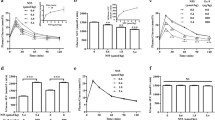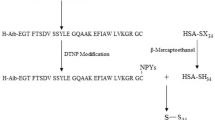Abstract
Objectives
We constructed a recombinant oral GLP-1 analogue in Lactococcus lactis (L. lactis) and evaluated its physiological functions.
Results
In silico docking suggested the alanine at position 8 substituted with serine (A8SGLP-1) reduced binding of DPP4, which translated to reduced cleavage by DPP4 with minimal changes in stability. This was further confirmed by an in vitro enzymatic assay which showed that A8SGLP-1 significantly increased half-life upon DPP4 treatment. In addition, recombinant L. lactis (LL-A8SGLP-1) demonstrated reduced fat mass with no changes in body weight, significant improvement of random glycemic control and reduced systemic inflammation compared with WT GLP-1 in db/db mice.
Conclusion
LL-A8SGLP-1 adopted in live biotherapeutic products reduce blood glucose in db/db mice without affecting its function.





Similar content being viewed by others
Data availability
Data used to support the findings of this study are available from the corresponding author upon request.
Abbreviations
- CFU:
-
Colony forming units
- db/db:
-
C57BLKS/J-Lepr-/Lepr- mouse
- DPP4:
-
Dipeptidylpeptidase 4
- EK:
-
Enterokinase
- GLP-1:
-
Glucagon-like peptide 1
- LBP:
-
Live biotherapeutic products
- LEISS:
-
LEISSTCDA synthetic propeptide sequence
- LC–MS:
-
Liquid chromatography-mass spectrometry
- LL-empty:
-
Lactococcus lactis Transformed with empty plasmid
- LL- WT GLP-1:
-
Lactococcus lactis Transformed with wild type GLP-1 plasmid
- LL-A8SGLP-1:
-
Lactococcus lactis Transformed with A8SGLP-1 plasmid
- Usp45:
-
Unknown secreted protein of 45 kDa
- GSIS:
-
Glucose-stimulated insulin secretion
- RG:
-
Random glucose
- oGTT:
-
Oral glucose tolerance test
References
Agarwal P, Khatri P, Billack B et al (2014) Oral delivery of glucagon like peptide-1 by a recombinant Lactococcus lactis. Pharm Res 31(12):3404–3414. https://doi.org/10.1007/s11095-014-1430-3
Arora T, Wegmann U, Bobhate A et al (2016) Microbially produced glucagon-like peptide 1 improves glucose tolerance in mice. Mol Metab 5(8):725–730. https://doi.org/10.1016/j.molmet.2016.06.006
Berman HM, Westbrook J, Feng Z et al (2000) The protein data bank. Nucleic Acids Res 28(1):235–242. https://doi.org/10.1093/nar/28.1.235
Bermudez-Humaran LG, Cortes-Perez NG, Le Loir Y et al (2003) Fusion to a carrier protein and a synthetic propeptide enhances E7 HPV-16 production and secretion in Lactococcus lactis. Biotechnol Prog 19(3):1101–1104. https://doi.org/10.1021/bp0340077
Broide E, Bloch O, Ben-Yehudah G, Cantrell D, Shirin H, Rapoport MJ (2014) Reduced GLP-1R Expression in Gastric Glands of Patients With Type 2 Diabetes Mellitus. J Clin Endocrinol Metab 99(9): E1691-E1695. https://doi.org/10.1210/jc.2014-1114
Cao WY, Dong M, Hu ZY et al (2020) Recombinant Lactococcus lactis NZ3900 expressing bioactive human FGF21 reduced body weight of Db/Db mice through the activity of brown adipose tissue. Benef Microbes 11(1):67–78. https://doi.org/10.3920/BM2019.0093
Ceriello A, Novials A, Ortega E, Canivell S, Pujadas G, La Sala L, Bucciarelli L, Rondinelli M, Genovese S (2013) Vitamin C further improves the protective effect of GLP-1 on the ischemia-reperfusion-like effect induced by hyperglycemia post-hypoglycemia in type 1 diabetes. Cardiovasc Diabetol 12(1):97. https://doi.org/10.1186/1475-2840-12-97
Charbonneau MR, Isabella VM, Li N et al (2020) Developing a new class of engineered live bacterial therapeutics to treat human diseases. Nat Commun 11(1):1738. https://doi.org/10.1038/s41467-020-15508-1
Cheang JY, Moyle PM (2018) Glucagon-like peptide-1 (GLP-1)-based therapeutics: current status and future opportunities beyond type 2 diabetes. ChemMedChem 13(7):662–671. https://doi.org/10.1002/cmdc.201700781
Chien T, Doshi A, Danino T (2017) Advances in bacterial cancer therapies using synthetic biology. Curr Opin Syst Biol 5:1–8. https://doi.org/10.1016/j.coisb.2017.05.009
Chiquette E, Toth PP, Ramirez G et al (2012) Treatment with exenatide once weekly or twice daily for 30 weeks is associated with changes in several cardiovascular risk markers. Vasc Health Risk Manag 8:621–629. https://doi.org/10.2147/VHRM.S37969
Deacon CF, Knudsen LB, Madsen K et al (1998) Dipeptidyl peptidase IV resistant analogues of glucagon-like peptide-1 which have extended metabolic stability and improved biological activity. Diabetologia 41(3):271–278. https://doi.org/10.1007/s001250050903
Drucker DJ, Philippe J, Mojsov S et al (1987) Glucagon-like peptide I stimulates insulin gene expression and increases cyclic AMP levels in a rat islet cell line. Proc Natl Acad Sci USA 84(10):3434–3438. https://doi.org/10.1073/pnas.84.10.3434
Drucker DJ, Rosen CF (2011) Glucagon-like peptide-1 (GLP-1) receptor agonists obesity and psoriasis: diabetes meets dermatology. Diabetologia 54(11): 2741–2744. https://doi.org/10.1007/s00125-011-2297-z
Farilla L, Bulotta A, Hirshberg B et al (2003) Glucagon-like peptide 1 inhibits cell apoptosis and improves glucose responsiveness of freshly isolated human islets. Endocrinology 144(12):5149–5158. https://doi.org/10.1210/en.2003-0323
Fehmann HC, Habener JF (1992) Galanin inhibits proinsulin gene expression stimulated by the insulinotropic hormone glucagon-like peptide-I(7–37) in mouse insulinoma beta TC-1 cells. Endocrinology 130(5):2890–2896. https://doi.org/10.1210/endo.130.5.1374016
Gao H, Zhao Q, Tang S et al (2021) Continuous stimulation of dual-function peptide PGLP-1-VP inhibits the morbidity and mortality of NOD mice through anti-inflammation and immunoregulation. Sci Rep 11(1):3593. https://doi.org/10.1038/s41598-021-83201-4
Ghoorah AW, Devignes MD, Smail-Tabbone M et al (2013) Protein docking using case-based reasoning. Proteins 81(12):2150–2158. https://doi.org/10.1002/prot.24433
Gibbons C, Blundell J, Tetens Hoff S et al (2021) Effects of oral semaglutide on energy intake, food preference, appetite, control of eating and body weight in subjects with type 2 diabetes. Diabetes Obes Metab 23(2):581–588. https://doi.org/10.1111/dom.14255
Hanas R, Ludvigsson J (1990) Side effects and indwelling times of subcutaneous catheters for insulin injections: a new device for injecting insulin with a minimum of pain in the treatment of insulin-dependent diabetes mellitus. Diabetes Res Clin Pract 10(1):73–83. https://doi.org/10.1016/0168-8227(90)90084-7
Holst JJ, Orskov C, Nielsen OV et al (1987) Truncated glucagon-like peptide I, an insulin-releasing hormone from the distal gut. FEBS Lett 211(2):169–174. https://doi.org/10.1016/0014-5793(87)81430-8
Hui H, Zhao X, Perfetti R (2005) Structure and function studies of glucagon-like peptide-1 (GLP-1): the designing of a novel pharmacological agent for the treatment of diabetes. Diabetes Metab Res Rev 21(4):313–331. https://doi.org/10.1002/dmrr.553
Jacouton E, Torres Maravilla E, Boucard AS et al (2018) Anti-tumoral effects of recombinant Lactococcus lactis strain secreting IL-17A cytokine. Front Microbiol 9:3355. https://doi.org/10.3389/fmicb.2018.03355
Kahles F, Meyer C, Möllmann J, Diebold S, Findeisen HM, Lebherz C, Trautwein C, Koch A, Tacke F, Marx N, Lehrke M (2014) GLP-1 Secretion Is Increased by Inflammatory Stimuli in an IL-6–Dependent Manner Leading to Hyperinsulinemia and Blood Glucose Lowering. Diabetes 63(10) 3221–3229. https://doi.org/10.2337/db14-0100
Knauf C, Cani PD, Perrin C et al (2005) Brain glucagon-like peptide-1 increases insulin secretion and muscle insulin resistance to favor hepatic glycogen storage. J Clin Investig 115(12):3554–3563. https://doi.org/10.1172/JCI25764
Kunitz M (1939) Formation of trypsin from crystalline trypsinogen by means of enterokinase. J Gen Physiol 22(4):429–446. https://doi.org/10.1085/jgp.22.4.429
Le Loir Y, Nouaille S, Commissaire J et al (2001) Signal peptide and propeptide optimization for heterologous protein secretion in Lactococcus lactis. Appl Environ Microbiol 67(9):4119–4127. https://doi.org/10.1128/AEM.67.9.4119-4127.2001
Lee YS, Jun HS (2014) Anti-diabetic actions of glucagon-like peptide-1 on pancreatic beta-cells. Metab Clin Exp 63(1):9–19. https://doi.org/10.1016/j.metabol.2013.09.010
Lee YS, Jun HS (2016) Anti-inflammatory effects of GLP-1-based therapies beyond glucose control. Mediat Inflamm 2016:3094642. https://doi.org/10.1155/2016/3094642
Lorenz M, Evers A, Wagner M (2013) Recent progress and future options in the development of GLP-1 receptor agonists for the treatment of diabesity. Bioorg Med Chem Lett 23(14):4011–4018. https://doi.org/10.1016/j.bmcl.2013.05.022
Luc K, Schramm-Luc A, Guzik TJ et al (2019) Oxidative stress and inflammatory markers in prediabetes and diabetes. J Physiol Pharmacol 70(6):111. https://doi.org/10.26402/jpp.2019.6.01
May AT, Crowe MS, Blakeney BA, Mahavadi S, Wang H, Grider JR, Murthy KS (2019) Identification of expression and function of the glucagon-like peptide-1 receptor in colonic smooth muscle. Peptides 112: 48–55. https://doi.org/10.1016/j.peptides.2018.11.007
Nadkarni P, Chepurny OG, Holz GG (2014) Regulation of glucose homeostasis by GLP-1. Prog Mol Biol Transl Sci 121: 23–65. https://doi.org/10.1016/B978-0-12-800101-1.00002-8
Perfetti R, Zhou J, Doyle ME et al (2000) Glucagon-like peptide-1 induces cell proliferation and pancreatic-duodenum homeobox-1 expression and increases endocrine cell mass in the pancreas of old, glucose-intolerant rats. Endocrinology 141(12):4600–4605. https://doi.org/10.1210/endo.141.12.7806
Piard JC, Hautefort I, Fischetti VA et al (1997) Cell wall anchoring of the Streptococcus pyogenes M6 protein in various lactic acid bacteria. J Bacteriol 179(9):3068–3072. https://doi.org/10.1128/jb.179.9.3068-3072.1997
Rinaman L, Comer J (2000) Antagonism of central glucagon-like peptide-1 receptors enhances lipopolysaccharide-induced fever. Auton Neurosci 85(1-3): 98–101. https://doi.org/10.1016/S1566-0702(00)00227-7
Rios AC, Moutinho CG, Pinto FC et al (2016) Alternatives to overcoming bacterial resistances: state-of-the-art. Microbiol Res 191:51–80. https://doi.org/10.1016/j.micres.2016.04.008
Ritzel U, Leonhardt U, Ottleben M et al (1998) A synthetic glucagon-like peptide-1 analog with improved plasma stability. J Endocrinol 159(1):93–102. https://doi.org/10.1677/joe.0.1590093
Rosenstock J, Allison D, Birkenfeld AL et al (2019) Effect of additional oral semaglutide vs sitagliptin on glycated hemoglobin in adults with type 2 diabetes uncontrolled with metformin alone or with sulfonylurea: the PIONEER 3 randomized clinical trial. JAMA 321(15):1466–1480. https://doi.org/10.1001/jama.2019.2942
Ryan GJ, Moniri NH, Smiley DD (2013) Clinical effects of once-weekly exenatide for the treatment of type 2 diabetes mellitus. Am J Health Syst Pharm 70(13):1123–1131. https://doi.org/10.2146/ajhp120168
Savijoki K, Kahala M, Palva A (1997) High level heterologous protein production in Lactococcus and Lactobacillus using a new secretion system based on the Lactobacillus brevis S-layer signals. Gene 186(2):255–262. https://doi.org/10.1016/s0378-1119(96)00717-2
Siegel EG, Gallwitz B, Scharf G et al (1999) Biological activity of GLP-1-analogues with N-terminal modifications. Regul Pept 79(2–3):93–102. https://doi.org/10.1016/s0167-0115(98)00155-4
Skrlec K, Rucman R, Jarc E et al (2018) Engineering recombinant Lactococcus lactis as a delivery vehicle for BPC-157 peptide with antioxidant activities. Appl Microbiol Biotechnol 102(23):10103–10117. https://doi.org/10.1007/s00253-018-9333-6
Steidler L, Hans W, Schotte L et al (2000) Treatment of murine colitis by Lactococcus lactis secreting interleukin-10. Science 289(5483):1352–1355. https://doi.org/10.1126/science.289.5483.1352
Steidler L, Neirynck S, Huyghebaert N et al (2003) Biological containment of genetically modified Lactococcus lactis for intestinal delivery of human interleukin 10. Nat Biotechnol 21(7):785–789. https://doi.org/10.1038/nbt840
Tong X, Xu J, Lian F et al (2018) Structural alteration of gut microbiota during the amelioration of human type 2 diabetes with hyperlipidemia by metformin and a traditional Chinese herbal formula: a multicenter, randomized, open label clinical trial. Mbio 9(3):1–12. https://doi.org/10.1128/mBio.02392-17
Tsend-Ayush E, He C, Myers MA et al (2016) Monotreme glucagon-like peptide-1 in venom and gut: one gene - two very different functions. Sci Rep 6:37744. https://doi.org/10.1038/srep37744
van Asseldonk M, Rutten G, Oteman M et al (1990) Cloning of usp45, a gene encoding a secreted protein from Lactococcus lactis subsp lactis MG1363. Gene 95(1):155–160. https://doi.org/10.1016/0378-1119(90)90428-t
Yu F, Han W, Zhan G et al (2019) Abnormal gut microbiota composition contributes to the development of type 2 diabetes mellitus in db/db mice. Aging (albany NY) 11(22):10454–10467. https://doi.org/10.18632/aging.102469
Yuan S, Dong M, Zhang H et al (2021) Oral delivery of a Lactococcus lactis expressing extracellular TGFbetaR2 alleviates hepatic fibrosis. Appl Microbiol Biotechnol 105(14–15):6007–6018. https://doi.org/10.1007/s00253-021-11485-7
Yusta B, Baggio LL, Koehler J, Holland D, Cao X, Pinnell LJ, Johnson-Henry KC, Yeung W, Surette MG, Bang KA, Sherman PM (2015) GLP-1R Agonists Modulate Enteric Immune Responses Through the Intestinal Intraepithelial Lymphocyte GLP-1R. Diabetes 64(7) 2537–2549. https://doi.org/10.2337/db14-1577
Zhang Y, Chen W (2012) Radiolabeled glucagon-like peptide-1 analogues: a new pancreatic beta-cell imaging agent. Nucl Med Commun 33(3):223–227. https://doi.org/10.1097/MNM.0b013e32834e7f47
Zhang H, Dong M, Liu X (2021) Obeticholic acid ameliorates obesity and hepatic steatosis by activating brown fat. Exp Ther Med 22(3):991. https://doi.org/10.3892/etm.2021.10423
Acknowledgements
We thank Dr. Jinkui Yang for providing the INS-1 cell line.
Funding
This study was supported by the General Program (Major Research Plan) of the National Natural Science Foundation of China [92057208], the China Postdoctoral Science Foundation [2021T140665], the Strategic Collaborative Research Program of the Ferring Institute of Reproductive Medicine [FIRMC180304] and the National Natural Science Foundation of China [81770834].
Author information
Authors and Affiliations
Contributions
Material preparation and GLP-1 and A8SGLP-1 expression system construction was performed by MD. SY analysed the stability of amino acid mutations. HZ and MD finished the in vitro cell experiment. HZ, MD and SY carried out the animal experiments. MD and WJ conceived the project and analysed the results. The first draft of the manuscript was written by HZ and all authors commented on previous versions of the manuscript. All authors read and approved the final manuscript.
Corresponding author
Ethics declarations
Conflict of interest
The authors have no relevant financial or non-financial interests to disclose.
Additional information
Publisher's Note
Springer Nature remains neutral with regard to jurisdictional claims in published maps and institutional affiliations.
Rights and permissions
Springer Nature or its licensor holds exclusive rights to this article under a publishing agreement with the author(s) or other rightsholder(s); author self-archiving of the accepted manuscript version of this article is solely governed by the terms of such publishing agreement and applicable law.
About this article
Cite this article
Zhang, H., Dong, M., Yuan, S. et al. Oral glucagon-like peptide 1 analogue ameliorates glucose intolerance in db/db mice. Biotechnol Lett 44, 1149–1162 (2022). https://doi.org/10.1007/s10529-022-03288-1
Received:
Accepted:
Published:
Issue Date:
DOI: https://doi.org/10.1007/s10529-022-03288-1




